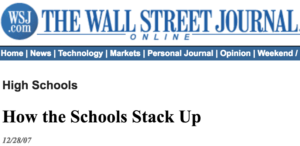
Weekend Journal looked at the freshman classes at eight top colleges — Harvard, Princeton, MIT, Williams, Pomona, Swarthmore, the University of Chicago and Johns Hopkins — and compiled a list of the students’ high-school alma maters. The survey ranked the high schools based on the number of students sent to those eight colleges, divided by the high school’s number of graduates in 2007 (*the last time this study was carried out), limiting the scope to schools that had senior classes of at least 50 (see below). The “success rate” column represents the percentage of students in each high-school’s graduating class that attended one of our chosen colleges. (see related story) — Compiled by Ellen Gamerman, Juliet Chung, SungHa Park and Candace Jackson
Correction
The Nov. 30 chart “How the Schools Stack Up” that ranked high schools with the best record of graduates attending eight top universities incorrectly omitted 20 high schools. The methodology called for determining the high schools attended by the current freshman classes at eight top colleges and then ranking the schools based on the percentage of their senior classes that attended those colleges. However, data from some of the colleges’ freshman facebooks and admissions offices were incomplete, and the Journal didn’t confirm the data with enough high schools. The rankings have been re-calculated after broadening the number of high schools. Some omissions remain possible.
From the top of the chart down, are the schools with the highest number of students sent to lowest.
Behind the Numbers:
Our survey looked at enrolled students, not the number of students accepted. In some cases, college admissions offices shared the list of high schools for their freshman classes. In others, we looked at the printed “facebooks” distributed by colleges, which were either loaned to us or purchased on our behalf by students or alumni.
We worked with high schools and colleges to verify our numbers, which sometimes differed when students had been accepted to college but deferred enrollment for a year or when college facebooks offered incomplete information. In cases where the high school and college’s numbers diverged, we worked with both to try to resolve the discrepancy.
We relied only on official school information, not outside sources such as Facebook.com. We omitted some universities that otherwise would have met our criteria because they either didn’t print facebooks or those facebooks didn’t list high-school alma maters, and the colleges wouldn’t supply the data on their students independently.
Of course, college placement is only one measure of a high school’s success, and varies from year to year. Many high schools emphasized to us that they strive to find the right match for each student, not the college with the most cachet.
(you may see the original article here)
